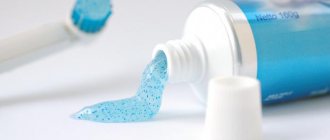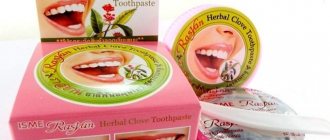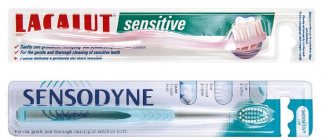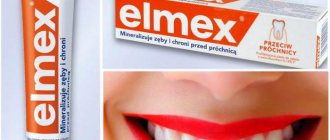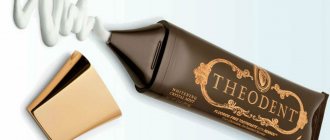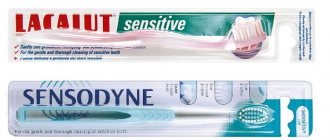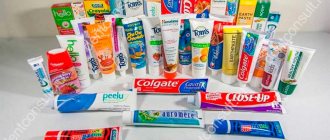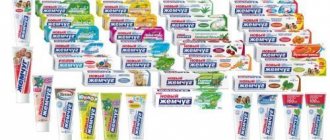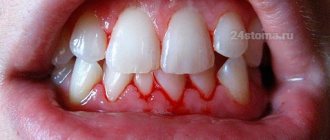In the beginning there was sand and chalk
Toothpaste and brush are everyday things with which our day begins and ends. However, they were once a real luxury. The ancient Egyptians were the first to think about oral hygiene and began to use sand, ash, ground stones and animal horns as a cleaning agent, and their own finger replaced the brush. In the 4th century BC. The great healer Hippocrates recommended using mixtures of pumice with the addition of wine vinegar, which are more gentle on tooth enamel, to prevent dental diseases. At the end of the 18th century, little had changed. For example, the British brushed their teeth with powders that included crushed brick, crushed bark and coal chips.
The prototype of modern toothpaste was invented by Americans in the 19th century. This time there were no stones or ash. Teeth cleaning products were a mixture of chalk powder, neutral soap and aromatic additives. It was only in 1873 that Colgate released the first toothpaste in glass jars, which replaced tubes two decades later. They were invented by dentist Washington Sheffield of New London. But Colgate beat the inventor by quickly registering a patent for itself. An interesting fact is that in Russia, most people at that time continued to brush their teeth with chalk-based powder, and only in the 50s it became possible to buy a familiar tube of toothpaste in stores.
Best toothpaste
Which toothpaste is better? Definitely one that meets a person’s needs and suits his indications. Until recently, the main task of toothpaste was to help the brush clean teeth from plaque. Today, modern manufacturers of hygiene products have expanded its functionality and began to offer special medicinal toothpastes, both complex and for targeted solutions to specific problems. Today you can find tubes not only for the prevention of caries, but also for bleeding gums, against the formation of tartar, paste for implants or smoker’s plaque, for fresh breath or restoring the pH balance of the oral cavity, as well as for much more. But, in fact, all pastes are divided into several varieties, which we will consider.
Positive effect
ROCS “BLACK EDITION” toothpaste (Black whitening) has a rich component composition that provides a pronounced positive effect on the tissues of the oral cavity. The main ingredients of this toothpaste are:
- Magnesium chloride and calcium glycerophosphate are compounds that contain active minerals - calcium, magnesium and phosphorus, presented in a special form that is similar (friendly) to the tissues of the human body. Due to this, they are easily absorbed, replenishing the deficiency of microelements;
- xylitol (obtained from grain crops) – promotes the absorption of calcium, has prebiotic properties and reduces the activity of cariogenic bacteria;
- bromelain (an enzyme obtained from the stems and fruits of pineapple) – has anti-inflammatory properties, gently but effectively dissolves plaque, reduces the formation of new plaque, preventing the fixation of bacteria on the oral mucosa and teeth;
- special polishing and whitening granules - delicately remove plaque, during the cleaning process they break down into smaller round particles and polish the enamel.
The paste contains natural black charcoal.
As a result of regular use of ROCS BLACK EDITION toothpaste:
- Plaque is carefully and effectively removed;
- the formation of new plaque is reduced, ensuring long-term cleanliness of the oral cavity;
- provides protection against most dental diseases, such as caries, gingivitis, periodontitis, etc.;
- enamel and dentin are remineralized, tooth tissue becomes stronger;
- Pigmentation (staining plaque) is removed from the surface of the teeth;
- the enamel acquires a natural whiteness and a beautiful healthy shine;
- symptoms of inflammation and bleeding gums are relieved;
- prevents the formation of tartar;
- The microflora of the oral cavity is normalized.
The positive effect of using ROCS “BLACK EDITION” toothpaste has been proven by laboratory and clinical studies.
Pastes for the prevention of dental caries
Toothpastes for the prevention of caries are recommended for increased susceptibility to the formation of caries bacteria, as well as as restorative therapy after teeth whitening. They saturate dental tissues with useful minerals, prevent the growth of carious bacteria, and also fight the formation of plaque. To strengthen teeth, fluoride compounds are added to such pastes. It is contained in such pastes as “Day and Night” Swiss Smile, Enzycal 950 CURAPROX, Mirafluor C Miradent, “Power of a Smile” Jason and others. Fluorine is an important microelement, since it is the one that participates in the metabolism of calcium, and, therefore, ensures its presence in the enamel. But it is worth remembering that it is extremely toxic, so its amount entering the body should not exceed the established norm. People living in areas with fluoride-saturated water (more than 1.2 mg/l) are advised to use fluoride-free toothpaste. You can find out about the fluoride content in the water in your area by calling the nearest Sanitary and Epidemiological Station.
Toothpaste
Theodent Classic
Pastes against tooth sensitivity
There are special toothpastes for sensitive teeth. They contain potassium chloride, potassium citrate (Twin Lotus Recipe for Sensitive Teeth, Mirasensitive hap+) or strontium chloride. These substances “clog” the dentinal tubules and reduce hyperesthesia. They also saturate the tooth enamel with minerals, the deficiency of which is most often the cause of increased sensitivity of enamel and dentin. But the most progressive substance today is considered to be hydroxyapatite (Sensitivity Control Biorepair). Its crystals are similar in composition to tooth enamel, so they effectively combine with it, restoring the natural protection of teeth. Pastes for sensitive teeth should not contain a drop of chemical bleaches and, instead of coarse calcium carbonate, should contain gentle abrasive substances with a smaller particle diameter, for example, silicon oxide. Such pastes are recommended for hypersensitive teeth, as well as for use during and/or after teeth whitening procedures.
Sensitivity Control Biorepair toothpaste
Price policy
Splat toothpaste, the price of which may seem quite high to some, is actually an excellent example of value for money. To put it very simply, it is better to spend a certain amount once a month on a good toothpaste than to then pay for a whitening procedure that will not give long-lasting results.
As for the cost, depending on the type, it can range from 40 to 150 rubles. Black paste with Karelian birch charcoal, the main purpose of which is whitening, costs on average 110-130 rubles, which is not that expensive, considering its quality.
Pastes for strengthening gums
Toothpastes aimed at preventing and reducing periodontal inflammatory processes reduce bleeding gums, help strengthen them, have an astringent effect, and also destroy harmful microbes. They most often contain antibacterial substances, for example with chlorhexidine, as in Curaprox ADS 712 paste, together with plant extracts that have an anti-inflammatory effect, such as edelweiss and echinacea in the SWISS SMILE vitamin herbal paste or witch hazel and calendula in the Plus Parodontgel BioRepair paste. Some of them also contain chlorophyll and vitamin E. All of these substances have a beneficial effect on gum tissue, accelerating the healing process and the formation of new cells. Such pastes are recommended for diseases of stomatitis, gingivitis and periodontitis.
Toothpaste Curasept ADS 712 CURAPROX
Pastes against bad breath
The action of toothpastes that help fight halitosis is aimed at restoring the normal balance of oral microflora, the disruption of which is usually accompanied by excessive proliferation of anaerobes. These substances emit volatile sulfur-containing products that have a pungent odor. Anti-bad breath pastes contain components that suppress pathogenic microflora and act on viruses. In addition, such pastes eliminate dry mouth syndrome, which can also cause halitosis. Antihalitic hygiene products are recommended for bad breath caused by microflora disturbances and dry mouth.
Enzymatic toothpaste gel
Jason Enzyme Brightening
Composition of toothpaste - which is better?
A dental hygienist can help you figure out which toothpaste is best for specific oral problems. When purchasing a product yourself, you need to pay attention to whether it contains substances potentially harmful to teeth. For example, coarse abrasive substances that negatively affect tooth enamel. These may be chalk or calcium carbonate, as well as aluminum oxides, which are prohibited in some countries. Nowadays, silicon dioxide is considered the best abrasive; it gently removes all dental plaque without having a negative effect on the enamel and gums. You can also find other safe abrasive substances in paste compositions—dicalcium phosphate or sodium metaphosphate.
You should be careful with toothpastes that contain triclosan or chlorhexidine. Brushing with such pastes may be necessary to treat inflammation in the gums or to eliminate bad breath. However, long-term use (more than 3 weeks) of paste with antibacterial substances can lead to disruption of the beneficial microflora of the oral cavity. If sodium lauryl sulfate is in one of the first places in the description of the composition (that is, its percentage is large), then it is also better not to buy such a paste. The fact is that this surfactant is responsible for foaming, but does not in any way affect the quality of cleaning. In addition, it has long been proven that even in small doses, sodium lauryl sulfate can negatively affect the body. This component is contained in all pastes from Blend-a-med, Colgate, Oral-B, Aquafresh, Karimed, Forest Balsam, some pastes from Lacalut, SPLAT, PresiDENT, and New Pearl.
What spoils our teeth
Changes in the color of tooth enamel are caused by such troubles as hormonal imbalances and lack of vitamins and minerals. Even stress can have a negative impact on the quality of our tooth enamel.
Unfortunately, the problem does not end there - external factors contribute to the darkening of the enamel to a much greater extent. For example, frequent consumption of drinks such as tea and coffee is very far removed from the desired Hollywood smile. The pigment contained in them has a fairly high degree of transmission - it gets clogged into microcracks in the tooth enamel and gradually spoils its color.
The water we regularly use for food has an equally detrimental effect. No matter how good the filtration is, there still remains a certain percentage of various salts and foreign impurities that gradually settle on the teeth, depriving them of their attractiveness.
How much does toothpaste cost and where to buy it?
The price of toothpaste varies from 50 to 1,000 rubles per tube, and sometimes can exceed this threshold. Some people think that expensive pastes are the best, others don’t see the difference in all the variety and buy the cheapest one. In both cases, the buyers are wrong. A high price does not always indicate the quality of a product, and buying cheap pastes is simply dangerous - they may turn out to be a fake or a product not manufactured in accordance with GOST. Where to buy toothpaste? This is best done in pharmacies and specialized stores, such as Startsmile Shop. You should not buy pasta in underground passages, at the market, on the train, or from “distributors.”
The choice of toothpaste determines many things - the appearance of teeth and gums, the condition of the enamel and its saturation with essential microelements. However, even the best toothpaste is not able to protect teeth from caries and gums from inflammation if cleaning is carried out quickly, poorly, incorrectly and irregularly.
Does charcoal toothpaste really whiten teeth?
First, let's make sure we all understand the difference between chemical and mechanical teeth whitening.
The first uses chemicals to remove internal deep stains, while the mechanical one uses abrasive ingredients that are added to toothpaste to remove external or superficial stains. Superficial stains on teeth are most likely “side effects” of your lifestyle, for example, smoking and drinking products with dyes - coffee, tea or red wine. Such stains are not so difficult to deal with, and mechanical bleaching, in general, will be sufficient.
Theoretically, the natural properties of activated carbon allow it to interfere with the structure of the stain and get rid of it faster. The dental benefits of this ingredient end there, and unless your teeth are naturally sparkling white, no amount of black toothpaste will help change their color.
